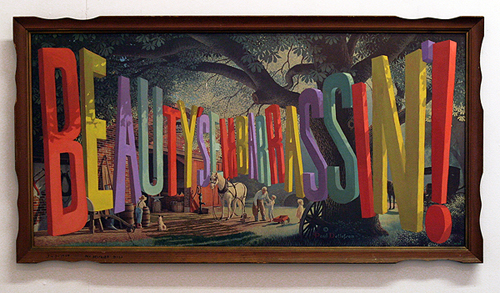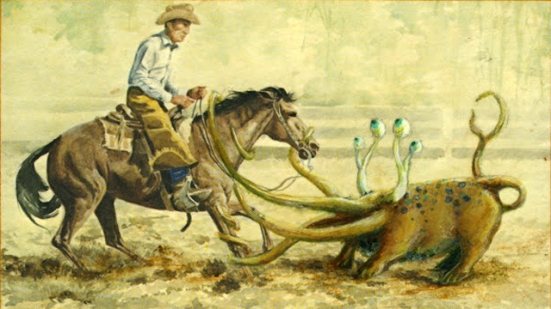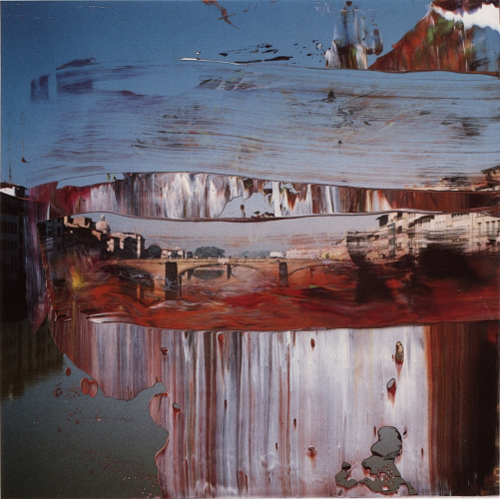This is a peek into the phenomena over painting Thrift store paintings, photographs and naive art.
A little of the – lost and found, old and new, innocent and humour-full
Collecting and exhibiting thrift store art is recognised as part of the ‘found art/paintings’ genre, except in this post the focus is entirely on involuntary contributions by way of over-painting existing artworks.
The technique and use of over-painting has been around for centuries. The use was most prolific in the renaissance period of the 16th – 17th century with a painting constructed over phases, starting with a under-painting sketch layer in neutral colours, followed by several layers of paint building up the image – this can be referred to as over-painting or pentimento. In art restoration there is also a practice of over-painting and in-painting when reconditioning old master pieces.
Firstly please don’t confuse the term overpainting with the recent and tragic event in where an elderly Spanish lady – Celia Gimenez, voluntarily carried out the worst attempt at restoration EVER on the painting ‘Ecce Homo’ by Elías García Martínez (in a little church in Borja, Spain). This ‘art foul’ hit global headlines in September 2012 – and the 80-year-old, with all her good intentions was ridiculed for her attempts and reached infamous acclaim all over the world. The Church has taken legal action and Ms Gimenez has since lawyered up and is now demanding to be paid for her services. I am NOT referring to this event as overpainting (but the aftermath certainly fits in) – in truth it is a travesty of epic proportions. If you have no idea what I am talking about check out the short heart breaking clip below.
‘Overpainting’ in a contemporary sense is like the above literal in its meaning, often changing a picture by painting additional parts over the top. the practice is thriving in unprecedented and unconventional ways, and even Banksy has attributed works from the take over the met exhibit in this style. The Italian word for this is Pentimento (plural pentimenti) . According to Wikipedia – The word is Italian for repentance, from the verb pentirsi, meaning to repent. The use of the word Pentimento in an art context means an alteration to a painting, often referring to the process where artists have made alterations during the composition of the artwork, usually between under-painting and subsequent layers. This term could be applied to this topic – who else agrees ‘Pentimento’ is a much nicer sounding word than overpainting?!?! But for continuity I will stick with the term of ‘overpainting’ for this post.
At university (approx. 2003) I had a tutor who primarily worked in the Naive art style and dabbled with this style of overpainting, she was interested in the context vs concept, what it means to add or subtract from an existing painting and a number of other philosophical questions related to carrying out this type of practice – all very deep complicated stuff. We also had a number of lectures on this subject as food for thought on contemporary arts. I always found it interesting in a light humorous way. I always try to keep an open mind, but personally find it difficult to accept this as a fine art practice of quality, must have expensive pieces – when anyone can replicate and/or personalise a piece of their own easily and so cheaply. Although, I could easily be persuaded if other variables were introduced for example a print of a Rubens was found with original Picasso alterations (The minefield of art vs authorship is for another discussion).
All that aside – a ‘how to’ in this contemporary craft movement involves sourcing thrift shop paintings, most often a scenery, but not always. Formulate an idea of what it is you want to paint into the existing picture. Source the required materials and get painting!! I have done a couple of works like this over the years which supported my style at the time. Here is a before and after of two of these few images for your reference.
Be very VERY careful when purchasing paintings or prints to paint over……….. There are so many articles and stories around the globe where expensive and rare examples of missing artworks have been found in thrift stores, So please, please purchase mass-produced prints (not worth a lot) for this type of activity. I would be devastated if you brought one of the following paintings got it home and painted some whimsical character evading a wizard with a pot of hot soup – only to find it was an original, rare and early work of Jackson Pollock and WAS worth at least a zillion dollars finders fee. Here are some people who had close calls and/or realised what they had stumbled upon.
- Woman buys valuable painting at Goodwill, almost painted over it
- From Renoir to Warhol: The Craziest and Most Lucrative Thrift Store Art Finds
- Rare Italian Painting Worth $12,000 Found In Goodwill Donation Bin In Virginia (VIDEO)
- Jackson Pollock painting, bought for five dollars, sold for 50 million
- Man Finds Picasso Original In Thrift Store






![MadonnaOfTheStreets1_thumb[2]-500x500](https://pepperboxcouture.files.wordpress.com/2013/03/madonnaofthestreets1_thumb2-500x500.jpg?w=382&h=382)


























I love this concept!
LikeLike
Me too, thanks for reminding me about them. I might go hunting for thrift store paintings today. 😉
LikeLike
🙂
LikeLike
I’ve been planning an overpainting job myself on this ugly church thrift sale find (http://wp.me/p31A6H-1k), so I loved this post. Thanks for the inspiration!
LikeLike
Hi, that ugly ugly painting of yours is perfect for a monster or three…… Ahaaha great find! 🙂
LikeLike
I will keep you posted on my progress. It will be good motivation.
LikeLike
Oh yes please do! 🙂
LikeLike
Cool stuff, Pepper! I still wonder exactly who trusted Sra. Gimenez with the ‘restoration’…!
LikeLike
What fun! Man, now I am so tempted to try some of this. As if I didn’t already have enough projects. 🙂
LikeLike
Put it on the project ‘after projects’ list. LOL. I can definately relate…
LikeLike
Great post! I enjoyed reading it 🙂
LikeLike
Dear lord… fail is right. Although I do appreciate the cut out ciggie break x
LikeLike
That’s my fav too!
LikeLike
Really interesting post. I draw like a two year old so any attempt will likely resemble “Ecce Homo”‘s restoration though!!!
LikeLike
LOL you have to learn to fake it before you make it. You could try printer image transfers, or tracing over an existing image with carbon paper underneath……. Then all you have to do is ensure you paint within the lines!! 🙂 HEY PRESTO!
Here’s a nifty vid on the process of transferring a printed image with acetone – http://www.youtube.com/watch?v=mv4d2zRPbG4
Hope that helps!
LikeLike
Wow, thanks for that!
LikeLike
I like these! If only I was a better painter… Hahaha
LikeLike
This is fun art. I have never seen this, so funny! Thank you for sharing!
LikeLike
You’re very welcome, glad you enjoyed the post!!
LikeLike